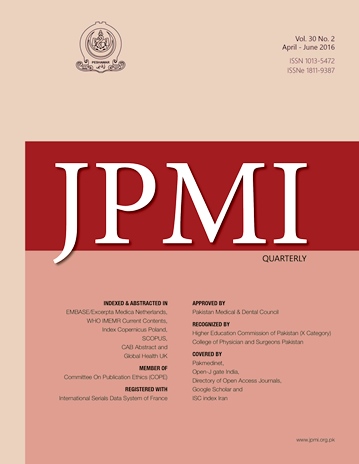DETECTION OF TEMPORAL BONE CHOLESTEATOMA BY MULTIDETECTOR COMPUTED TOMOGRAPHY
Main Article Content
Abstract
Objective: To determine the CT patterns of temporal bone cholesteatoma in
patients presenting with chronic discharge from ear.
Methodology: This was a cross-sectional study conducted at Department
of Radiology, Rehman Medical Institute Peshawar from January 2013 to June
2014. 78 patients with chronic discharging ear, who were referred from E.N.T
outpatient department, were included in the study. All scans were performed
on 128 slice Multidetector Computed tomography (MDCT) scanner.0.5mm reconstructed
images in bone window and 3mm images in soft tissue window
were viewed on 5.1 vitrea workstation in axial, coronal and sagittal planes.
The CT studies were correlated with clinical examination findings, surgical and
histopathology. Basic radiologic patterns of cholesteatoma described on CT
scan were assessed. The data was processed using Microsoft excel 2007.
Results: Cholesteatoma was present in 48 (61%) cases. The disease was bilateral
in 7 cases (14 %), 39 (81 %) were unilateral. 25(52%) were left sided and
14 (29%) right-sided. 24 (30 %) patients were characterized as having otomastoiditis
whereas 7(8%) patients were radiologically difficult to characterize if
they were cholesteatoma or not.
Conclusion: Cholesteatomas can cause bone erosions and should be detected
early. The important role of MDCT lies in the early detection of cholesteatoma,
and more conservative surgical procedures can be used to eradicate
the disease.
patients presenting with chronic discharge from ear.
Methodology: This was a cross-sectional study conducted at Department
of Radiology, Rehman Medical Institute Peshawar from January 2013 to June
2014. 78 patients with chronic discharging ear, who were referred from E.N.T
outpatient department, were included in the study. All scans were performed
on 128 slice Multidetector Computed tomography (MDCT) scanner.0.5mm reconstructed
images in bone window and 3mm images in soft tissue window
were viewed on 5.1 vitrea workstation in axial, coronal and sagittal planes.
The CT studies were correlated with clinical examination findings, surgical and
histopathology. Basic radiologic patterns of cholesteatoma described on CT
scan were assessed. The data was processed using Microsoft excel 2007.
Results: Cholesteatoma was present in 48 (61%) cases. The disease was bilateral
in 7 cases (14 %), 39 (81 %) were unilateral. 25(52%) were left sided and
14 (29%) right-sided. 24 (30 %) patients were characterized as having otomastoiditis
whereas 7(8%) patients were radiologically difficult to characterize if
they were cholesteatoma or not.
Conclusion: Cholesteatomas can cause bone erosions and should be detected
early. The important role of MDCT lies in the early detection of cholesteatoma,
and more conservative surgical procedures can be used to eradicate
the disease.
Article Details
How to Cite
1.
Gul S, Siddique Umer U, Alam S, Ghaus S, Khan MS, Javed S. DETECTION OF TEMPORAL BONE CHOLESTEATOMA BY MULTIDETECTOR COMPUTED TOMOGRAPHY. J Postgrad Med Inst [Internet]. 2016 Apr. 28 [cited 2025 Dec. 5];30(2). Available from: https://jpmi.org.pk/index.php/jpmi/article/view/1724
Issue
Section
Original Article
Work published in JPMI is licensed under a
Creative Commons Attribution-NonCommercial 2.0 Generic License.
Authors are permitted and encouraged to post their work online (e.g., in institutional repositories or on their website) prior to and during the submission process, as it can lead to productive exchanges, as well as earlier and greater citation of published work.


